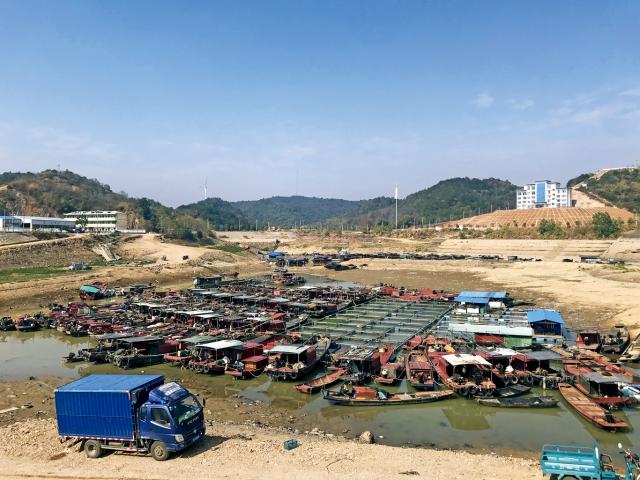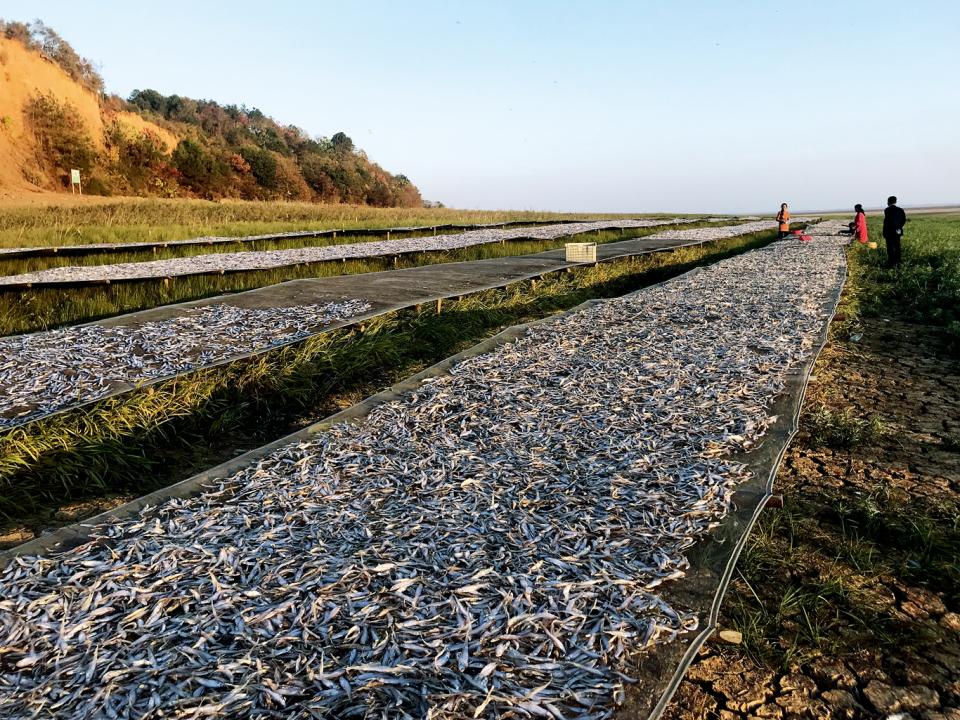With the depletion of species in the Yangtze at a tipping point, the central government has enforced a 10-year fishing ban on the entire river
Back in 2012, conservation biologist Hao Yujiang was shocked by what he found. There had been a dramatic drop in Yangtze River finless porpoises. Unique to China’s longest river, the freshwater cetacean is distributed mainly in its middle and lower reaches, Dongting Lake and Poyang Lake.
Their population plummeted from around 1,800 in 2006 to 1,040 in 2012 and protection measures did not keep pace. Experts point to the lack of food sources. At the top of the river’s ecological food chain, the finless porpoise was first to suffer from dwindling fish.
During a meeting for the development of the Yangtze River Economic Belt in 2018, Chinese President Xi Jinping said the river’s biological integrity index had fallen to the lowest category: “fish-free.”
But this was not a new issue. Statistics show that the natural fishing volume of the Yangtze River had fallen from 427,000 tons in 1954 to less than 100,000 tons today, accounting for 0.15 percent of the country’s freshwater and aquatic products.
After years of calls from preservation experts for a complete fishing ban on the Yangtze River, the central government implemented a 10-year fishing ban that took effect on January 1.
Shrinking Gene Pool
Zhan Xingwang’s family has been fishing on Poyang Lake for generations. Like most fishermen in the area, Zhan, in his 50s, had little schooling and only speaks the local dialect. His greatest memories of Poyang Lake were on his parents’ fishing boat in the 1960s and 70s. Fish were abundant at that time. He remembers how one cast of the net could yield a 15- to 20-kilogram fish. He once caught a 50-kilogram fish. Nowadays, the biggest fish he catches are between five and 10 kilograms. And numbers have significantly reduced since then.
The situation on Poyang Lake, the largest freshwater lake in China connected to the Yangtze River, is not unique. Fish resources are drying up throughout the entire river basin – one of the most biodiverse rivers in the world. According to data from the Ministry of Agriculture and Rural Affairs, the Yangtze River is home to more than 4,300 aquatic species including 424 species of fish. More than 170 fish species are unique to the Yangtze River.
Herring, grass carp, silver carp and bighead carp are the four major species harvested from the Yangtze River. But breeding in natural fisheries is less than 10 percent of what it was in the 1960s. The reduction in wild species has caused long-term hidden effects. About 93.78 percent of China’s freshwater products are from aquaculture.
“Artificial feeding in aquaculture degrades the genetic pool,” said Cao Wenxuan, a fishery biologist at the Chinese Academy of Sciences who was among the first to propose a 10-year fishing ban on the Yangtze. Cao told NewsChina that because cultured fish genes tend to degenerate, fish populations must be replenished with wild fish eggs for breeding. The Yangtze River provides an indispensable gene pool for the four major fish species. “If we don’t protect the fish gene pool, we will really face the sad and terrible reality of having no fish to eat in the future,” said Cao.
Decreased fish threaten the survival of all rare aquatic organisms in the Yangtze River. According to Hao Yujiang, an associate researcher in the Department of Cetacean Conservation Biology, Institute of Hydrobiology at the Chinese Academy of Sciences, the decline in the Yangtze finless porpoise population accelerated in the 1990s. His study shows that the generation period for the Yangtze River finless porpoise has shortened since 1993 and the proportion of male offspring increased. “This may be related to the serious deterioration of fishery resources caused by overfishing and environmental degradation in the river,” Hao said.
He said that excessive human intervention such as overfishing and environmental destruction has forced the porpoise population to adapt by producing more male offspring than female offspring so as to create a gender imbalance, limiting growth in their numbers.
In 2012, the rate of decline in the porpoise population increased from 6.5 to 13.7 percent. If this rate continues, the porpoise will disappear from the main stream of the Yangtze River within 15 years. This projection shocked authorities and the need for protection of the Yangtze River drew public attention.
Other rare and unique species in the Yangtze River are also on the decline. NewsChina learned that after the Yangtze River dolphin was declared functionally extinct in 2007, two other species, including the white sturgeon and Yangtze River sturgeon have not been seen for many years. There are 79 fish species threatened in the upper reaches of the river.
Explosive Methods
Cao Wenxuan, who has been studying the Yangtze River Basin for years, told the reporter that fishermen have resorted to illegal methods that involve electricity and explosives. Cao recalled that since 1980s, almost every ship on the Han River and Xiang River, major tributaries of the Yangtze, had electrified fishing nets. Another illegal fishing method widely used involves laying long nets with extremely small mesh underwater that do not allow smaller fish and shrimp to escape.
Cao’s students visited Dongting Lake in July 2004. They noticed that most of the fish caught on fishing boats were young fish measuring about 10 centimeters.
Fish stunners and small mesh nets have exhausted the Yangtze River’s fish resources, Cao Wenxuan told the reporter, adding that electrofishing also threatens rare species such as the Yangtze sturgeon and porpoise.
According to Zhan Xingwang, the number of fishermen is on the rise, and that despite China’s Fisheries Law prohibiting explosives, poison and electricity from fishing, these illegal measures are widely used.
To combat the decline of fishery resources, the former Ministry of Agriculture began annual fishing bans in the Yangtze River in 2002. All fishing operations were prohibited from February 1 to April 30 in the upper stream above the Gezhou Dam at Yichang, Hubei Province, and from April 1 to June 30 below the dam. In 2016, the Ministry of Agriculture expanded the spring fishing ban from March 1 to June 30.
But despite these measures, overfishing and illegal fishing still made a comeback, prompting Cao Wenxuan to begin his 10-year campaign for a complete ban on fishing in the Yangtze River Basin. Ren Wenwei from the World Wildlife Fund (WWF) explained that fish populations could recover if they were only allowed to recuperate. “Even more importantly, every wild fish caught is a valuable genetic resource now,” Ren told the reporter: “A 10-year ban could effectively protect the genetic resources of aquatic life in the Yangtze.”
Other experts from the Institute of Hydrobiology, CAS, endorsed Cao and called for a10-year ban on fishing. Real change came at the 18th National Congress of the Communist Party of China in 2012 when the central government focused more on environmental issues. Hao Yujiang felt that over the past five to 10 years, the government and society have improved protection of the finless porpoise. “This was both a gradual as well as a sudden process,” Hao said.
At a 2016 forum on promoting the development of the Yangtze River economic belt, Xi promoted the policy to restore the river’s ecology and prohibit mass exploitation. In January 2017, authorities took the lead in launching a 10-year fishing ban in the Chishui River Basin, an important spawning area for rare fish in the upper reaches of the river.
In 2018, the State Council issued targets that included a year-round fishing ban in key areas of the Yangtze River Basin by 2020 and marked improvements to the Yangtze River Basin’s ecology and aquatic resources by 2035.
At the beginning of 2019, three ministries including the Ministry of Agriculture and Rural Affairs issued a plan to implement the fishing ban and compensation for fishing industry workers in key waters of the basin. The plan clearly states that the 10-year recuperation period will begin in 2020.

Fishing boats moor on the bank of Poyang Lake during the dry season when the water retreats

A fishmonger buys fresh catches from fishermen near Poyang Lake
Multiple Causes
The Yangtze River is the third-longest river in the world at some 6,300 kilometers. It flows through 11 provinces, municipalities and autonomous regions. “The Yangtze River Basin has a population density and industrial activity unprecedented in world history,” Ren Wenwei said. During a previous inspection along the Yangtze River, Ren and his team observed legally and illegally built hydropower stations. Ren said the vegetation surrounding the stations was seriously damaged.
At the first Yangtze River Biological Resources Conservation Forum held in Shanghai in 2007, experts concluded that not only was overfishing to blame for the depletion of fish, but other human activities including damming, water pollution, sand dredging and land reclamation were contributing factors to habitat degradation.
According to statistics provided by the Yangtze River Basin Fisheries Administration, Supervision and Management Office, there are over 52,000 dams in the Yangtze River Basin, and 127 large hydropower stations are planned for the upper reaches of the main stream and tributaries. These dams have had a tremendous impact on the environment. By the end of 2017, a total of 2.41 million small hydro projects had been built in 10 provinces and cities along the Yangtze River, and 333 rivers stretching a total of 1,017 kilometers were cut off. Hydropower stations not only block the way for fish returning to their spawning grounds, but also change the hydraulic conditions and water temperature of the Yangtze River. The result is a significant reduction in the fish eggs produced. According to a China Central Television report, in the 1990s, the average runoff of eggs and larvae for the river’s four main fish species was 2.5 billion. That has dropped to 100 million in recent years.
Water pollution also threatens aquatic organisms. In 2017, the amount of industrial waste discharged from the Yangtze River Basin exceeded 30 billion tons. Ren told the reporter that such water pollution causes death or decreases immunity of aquatic organisms and increases diseases.
“The even more influential factor on the survival of aquatic life is climate change, which causes extreme weather to degrade the environment,” Ren said, adding that besides a simple fishing ban, comprehensive scientific research must be conducted to find effective and systematic solutions.
On July 1, 2019, the city of Ma’anshan, Anhui Province completed the fishing ban assignment ahead of schedule. Xia Dejun, an official from the local fishery department, told the reporter that implementation of the policy has brought significant changes. He said that now finless porpoises are sighted on every inspection of the river. “Because the finless porpoise eats fish, their increasing numbers indicate the fishing ban is effective,” Xia said.
Hao Yujiang also is hopeful. A 2017 ecological survey placed the finless porpoise population at 1,012. Although slightly lower than five years earlier, the population has not decreased significantly, which from a statistical perspective indicates the rapid decline has been contained and the protection measures are taking effect. But Hao admits: “Threats to the survival of the Yangtze porpoise population are still not eliminated, and there is a still long way to go in protection work.”

 Old Version
Old Version

